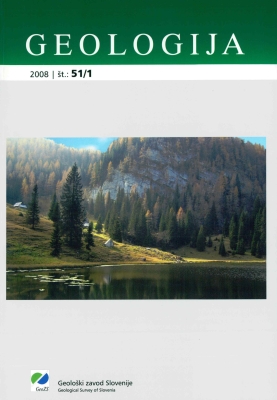Hydrogeochemical characteristics of the River Idrijca (Slovenia)
DOI:
https://doi.org/10.5474/geologija.2008.004Abstract
The hydrogeochemical and isotope characteristics of the River Idrijca, Slovenia, where the world's second largest mercury (Hg) mine is located, were investigated. The River Idrijca, a typical steep mountain river has an HCO3- - Ca2+ - Mg2+ chemical composition. Its Ca2+/Mg2+ molar ratio indicates that dolomite weathering prevails in the watershed. The River Idrijca and its tributaries are oversaturated with respect to calcite and dolomite. The pCO2 pressure is up to 13 times over atmospheric pressure and represents a source of CO2 to the atmosphere. δ18O values in river water indicate primary control from precipitation and enrichment of the heavy oxygen isotope of infiltrating water recharging the River Idrijca from its slopes. The δ13CDIC values range from -10.8 to -6.6 ‰ and are controlled by biogeochemical processes in terrestrial environments and in the stream: 1) exchange with atmospheric CO2, 2) degradation of organic matter, 3) dissolution of carbonates, and 4) tributaries. The contributions of these inputs were calculated according to steady state equations and are estimated to be -11 %: 19 %: 31 %: 61 % in the autumn and 0 %: 6 %: 9 %: 35 % in the spring sampling seasons.Downloads
How to Cite
Kanduč, T. (2008). Hydrogeochemical characteristics of the River Idrijca (Slovenia). Geologija, 51(1), 39–49. https://doi.org/10.5474/geologija.2008.004
Issue
Section
Articles

